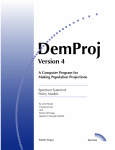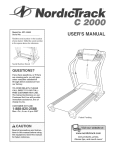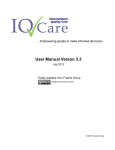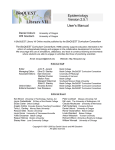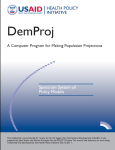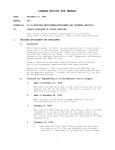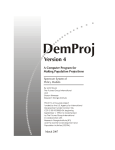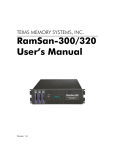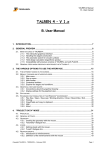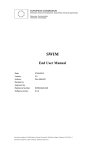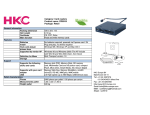Download OneHealth Startup Manual
Transcript
OneHealth User MANUAL OneHealth Start-up Manual A Computer Program for Making Informed Health Programming Decisions iii ONEHEALTH Start up MANUAL (Draft 2012 11 19) iv OneHealth Start-up Manual (Draft 2011 12 10) One Health Start-up Manual A Computer Program for Making Informed Health Programming Decisions November 2012 v ONEHEALTH Start up MANUAL (Draft 2012 11 19) The development of the OneHealth software and manual was supported by the World Health Organization, the Global Workforce Health Alliance, UNFPA, UNICEF, the Health Metrics Network and The Global Fund to fight AIDS, Tuberculosis and Malaria. It was prepared by Shetal Datta and Bill Winfrey of Futures Institute. Overall technical guidance on the development of the OneHealth tool is provided by the United Nations inter agency working group on Costing. The views expressed in this publication do not necessarily reflect the views of the funding organizations. vi OneHealth User MANUAL TABLE OF CONTENTS INTRODUCTION .................................................................................................................. 5 BASIC STEPS IN INSTALLING AND USING ONEHEALTH .................................................. 6 Step 1: Obtain software ................................................................................................................ 6 Step 2: Install OneHealth ............................................................................................................ 7 Step 3: Launch Spectrum ............................................................................................................ 7 Step 4: Ensure that you are in OneHealth mode ....................................................................... 8 Step 5: Create a new projection. ............................................................................................... 10 Step 6: Open an existing projection. ........................................................................................ 13 NAVIGATING ONEHEALTH ................................................................................................ 15 Icon Groups, Icons, Ribbons and Menus ..................................................................................... 15 Right click functions ..................................................................................................................... 15 Copying from Windows applications into OneHealth ................................................................ 16 Technical assistance ...................................................................................................................... 16 MODULES AND FEATURES OF ONEHEALTH .................................................................... 19 Programme costing or delivery channel costing ......................................................................... 19 Intervention coverages ................................................................................................................. 19 Bottleneck review .......................................................................................................................... 19 Human resources ..........................................................................................................................20 Infrastructure ................................................................................................................................20 Logistics .........................................................................................................................................20 Health financing ............................................................................................................................ 21 Health information systems ......................................................................................................... 21 Governance .................................................................................................................................... 27 SPECIAL TOPICS ................................................................................................................ 28 Creating comparison scenarios .................................................................................................... 28 Opening multiple scenarios .......................................................................................................... 29 Sharing scenarios .......................................................................................................................... 29 iii ONEHEALTH Start up MANUAL (Draft 2012 11 19) Viewing results side by side (Using the “Group” function) ........................................................ 29 Equity Analysis .............................................................................................................................. 32 Creating a sub-national projection............................................................................................... 33 Installing and running OneHealth on a Mac/Apple computer .................................................. 37 TROUBLE SHOOTING ........................................................................................................ 39 OneHealth modules cannot be activated ..................................................................................... 39 TB deaths averted are not being reported ...................................................................................40 Zero services are reported for an intervention ............................................................................ 41 Zero costs are reported for an intervention ................................................................................. 42 Unusually large costs or unusually large number of services are reported for an intervention42 APPENDIX: COUNTRIES WITH DEFAULT DATA .............................................................. 43 APPENDIX: POPULATION AND COVERAGE CONCEPTS .................................................. 50 iv OneHealth Start-up Manual (Draft 2011 12 10) INTRODUCTION OneHealth is a tool that can be used to inform the development of strategic plans for health sector planning. The software was developed to respond to country requests for a single tool which reflects the best aspects of the existing tools. The OneHealth tool provides a unified framework to strengthen integrated planning. OneHealth is a single mechanism to be used for supporting the planning, costing and budgeting of health sector priorities, including health system strengthening strategies. As such it represents a modular instrument for program-specific and sector-wide applications. The tool illustrates the health system implications of scaling up intervention delivery, shows the capital investment gap and allows a comparison of costs with the estimated financial resources available. In this manner, the tool facilitates scenario generation and informs priority setting processes. The identification of impediments to intervention scaleup emphasizes the need to strengthen systems for sustainable long term planning. The tool facilitates an assessment of costs related to the areas of maternal, newborn and reproductive health, child health, vaccination, malaria, tuberculosis, HIV/AIDS, nutrition, and water sanitation and hygiene, to inform progress towards the Millennium Development Goals, including assessment of achievable health impact. In addition it contains modules for the areas of human resources, infrastructure, logistics, financial space, programme and channel analysis, intervention coverage and costing, bottleneck analysis, programme costing, summary outputs and budgeting. Potentially, OneHealth has a multiplicity of users. At the most comprehensive, health planners putting together a multi-year health plan can use the tool to create a costed plan for addressing critical health needs in a country; to compare different scenarios for reaching the identified health sector priority goals. This could be as part of a national strategic health planning exercise or as a part of a proposal to a multi-lateral funding organization. At a simpler level, disease area planners can use the programme planning modules to develop plans addressing their particular needs with reference to health systems as appropriate. Similarly, health systems planners can use the systems modules to make medium and long range plans for Human Resources, Infrastructure, Logistics, etc. as appropriate. The added value of OneHealth is generated when multiple modules are used at the same time, to identify synergies and to ensure that planning processes take into account systemic constraints. The purpose of this manual is to guide the user through a step-by-step process of downloading and getting started with the OneHealth tool. It is not meant to be comprehensive. After the user is launched into the tool, Help screens that will guide and inform the user as s/he implements the tool. OneHealth is a work in progress that is continuously adapting to meet the needs of countries and health organizations. The user is advised to check back on the Futures Institute website periodically for released newer versions of OneHealth software and the OneHealth Start-up Guide. A technical manual will also be made available through the website. As of November 2, 2011, OneHealth included complete modules for programme-specific analysis and costing, delivery channel analysis and costing, human resources, logistics, infrastructure, financial space and budgeting. Initial simple versions exist for the modules of health financing, health information systems and governance. 5 ONEHEALTH Start up MANUAL (Draft 2012 11 19) BASIC STEPS IN INSTALLING AND USING ONEHEALTH This section provides instructions for downloading and installing the OneHealth tool as well as creating a projection. The user is also encouraged to explore other parts of OneHealth and SPECTRUM to become familiar with the full array of features and options. Step 1: Obtain software 1. Download OneHealth from the internet at http://spectrumbeta.futuresinstitute.org The Futures Institute Beta site is a website for making available beta versions of the tool that are still under development and not yet publicly released. 2. Click on the links indicated above to download the OneHealth Tool and Start Up Manual. The OneHealth Tool is approximately 25MB and the manual about 10MB in size. 3. 6 Save to your desktop or other easy to find file location when prompted. OneHealth Start-up Manual (Draft 2011 12 10) Step 2: Install OneHealth 1. Click on the file that you have downloaded to initiate installation. If you have saved the file to your desktop, click on the icon– “OneHealthInstall.EXE”. 2. Click next at all of the prompts and click finish at the end when OneHealth is installed. Step 3: Launch Spectrum 1. Click the Start menu from the bottom left hand corner of screen. From the “All programs” menu item, find OneHealth, and click on the rainbow icon. 7 ONEHEALTH Start up MANUAL (Draft 2012 11 19) Note to previous users of SPECTRUM: OneHealth is programmed within the SPECTRUM suite of health policy tools. If you have previously used SPECTRUM1, OneHealth may need to be launched from the SPECTRUM icon of a previously installed version. Step 4: Ensure that you are in OneHealth mode 1. If you are a first-time user of OneHealth (or SPECTRUM), you should see the following screen. Note that OneHealth is in the banner at the top. If you see “Spectrum” at the top, follow the directions immediately below. Special Instructions for when “Spectrum” appears in banner at top & for changing language options: 1. Click on the rainbow icon in the upper left hand corner. 2. Click on Options in the lower right hand corner of the dialog box. 1 8 Among its various tools SPECTRUM includes DemProj, FamPlan, AIM and Goals. OneHealth Start-up Manual (Draft 2011 12 10) 3. Assure that “Enable OneHealth Layout” is checked. 4. Note that you may also change language settings in this dialog box. As of November 2, 2011, partial translations of the tool have been made for French and Spanish. The other languages indicated may be clicked but translations will be visible only for other features of SPECTRUM. 5. Click OK to return to the Welcome screen. Note that at any time you may re-show the Welcome Screen by clicking on the rainbow icon with the word “Welcome” next to it. 9 ONEHEALTH Start up MANUAL (Draft 2012 11 19) Step 5: Create a new projection. 1. Click on the item “New Projection” in the Welcome screen. You should see the following dialog screen. 2. Click on “Projection file name” to create a name for your projection. Locate the projection in a folder where you can easily find it. What is a scenario? Within OneHealth scenarios are alternative visions of the future or apply alternative costing assumptions. For example, a user may wish to compare the costs associated with decreasing Under 5 The basic unit of analysis for mortality by half percent versus the costs of decreasing Under 5 OneHealth is the projection. mortality by one third. Alternatively, a user may want compare As many as ten projections the costs of alternative strategies, e.g., community focused may be open in a single session programme versus clinic focused programme for decreasing under of OneHealth. Different 5 mortality by half. These comparisons are made possible by projections can be built from a creating a specific scenario for each alternative. basic projection to analyze the cost and impact implications of different health scale up plans. As a general rule, we recommend that the user first create a “Base” 10 OneHealth Start-up Manual (Draft 2011 12 10) scenario which includes all of the basic set up for the health system and programmes. We then recommend that the user replicate this Base scenario to build different visions of the future. 3. Click on the “?” next to the years to inform your decision about the First Year, Final Year and Timeframe for health system analysis. 4. Leave all modules checked on as shown. 5. Click on Country data. You should see the following dialog screen. 11 ONEHEALTH Start up MANUAL (Draft 2012 11 19) 6. Select your country from list in the left hand panel. Leave the TFR and Life expectancy assumptions as the medium projections as shown in this dialog box unless you have consulted with a demographic expert. OneHealth will automatically load demographic modules and specific impact modules for HIV, Family Planning, Maternal and Child Health (Lives Saved Tool) and TB epidemiological information for the country you have selected in most cases. See appendix for a list of countries with default data. Note however that in some cases OneHealth will load regional values for child survival data and representative values for family planning if data are not currently available to the tool. The appendix “Countries with Default Data” lists the various countries that include default data. When regional or representative data have been loaded a notice will appear. It is recommended that you review and edit the family planning and mortality data in the FamPlan and LiST modules if you receive this notice. For several countries default data do not exist for the TB module. In those cases you will be alerted to turn off the TB module. For a couple of countries there is no default HIV data. For those countries you may enter data of your own into the AIM module of OneHealth or you may proceed with the assumption that HIV prevalence is zero if it is an accurate assumption. 7. Click OK. 8. At this point you will be asked to make selections about how you would like for your projection to be configured. You will be prompted to choose between programme mode or delivery mode; target setting mode or policy mode for human resources; and costing template mode or optimizer mode for logistics. In each case, accompanying text in the model will guide your decisions. The decision about programme mode or delivery channel mode is irreversible. The decisions about human resources and logistics can be reversed at any time. 9. You should now have arrived at the following dialog box. Your projection is successfully created. 12 OneHealth Start-up Manual (Draft 2011 12 10) We recommend that you first save your projection and then return to this editor to customize your projection to fit your country’s health system. 10. Click on Close, then click on the rainbow icon in the upper left corner, and click “Save”. Until you click save, nothing is actually stored permanently. You may return to the OneHealth Configuration to customize your projection by clicking on the OneHealth Configuration icon. Step 6: Open an existing projection. If you are returning to OneHealth after having closed the tool, you may open your projection by clicking on “Open existing projection” in the welcome screen or with the file management system accessible via the rainbow icon. If you have received a projection from a colleague follow the following sub-steps. 1. Save the file or files to an easy to find folder on your computer’s hard drive. Please take note if you have received a collection of many files with extensions such as *.pjn, *.cs, *.aim, etc. or a single file with the extension *.zip. 2. Launch Spectrum. 3. Go to the rainbow icon. a. If you received many files from your colleague as described above, click on “Open projection” and use the file management dialog to find the projection on your hard drive. 13 ONEHEALTH Start up MANUAL (Draft 2012 11 19) b. If you received a single “Zip” file, click on “Import projection” and and use the file management dialog to find the projection on your hard drive. OneHealth allows you to open multiple projections. After having opened one projection, you may open as many as ten projections simultaneously. To assure consistency, all projections must have the same basic set up. Most importantly they must have the same planning horizon and include the same modules. Certain other details must also be the same such as planning modality (i.e., programme mode vs. delivery mode). If you attempt to simultaneously open a projection that is not consistent with the currently loaded projection, OneHealth will generate an error message and refuse to open the additional projection. At this point we leave you to explore the OneHealth Tool and fill it with the data applicable to your country and create scenarios to compare alternative visions for the future. The remainder of this manual addresses the following issues: 1. Navigating OneHealth 2. Description of the OneHealth Modules 3. Special topics We recommend that you look carefully at the chapter on Navigation as it contains many hints that can make use of OneHealth much simpler. We recommend that you skim the remainder of the manual to familiarize yourself with the content. You may want to later return to the manual when you need to use particular features. 14 OneHealth Start-up Manual (Draft 2011 12 10) NAVIGATING ONEHEALTH This next section will help a new user to become familiar with all of the different functions within OneHealth. A simple screen snapshot will be shown to you with a set of numbers next to the icon, or tab of the model that is being explained. Below the screenshot the user will find the explanation of each number/icon/tab. Icon Groups, Icons, Ribbons and Menus In general, OneHealth has four levels of menus for editing data and using features. At the top are Icon groups including Home, Health Services, Health Systems and Impact Modules. Each of these Icon groups has a set of icons associated with it. These Icons may lead to OneHealth modules, configuration elements or tools. At a third level, each module Icon has a ribbon associated with it. In the example shown below, for the programme area Maternal/Newborn and Reproductive Health, situation analysis, intervention costing, bottleneck analysis, programme costing and results constitute the ribbon. Each element on the ribbon leads to a drop down menu that allow access to data editing screens, background information or results. The chapter “Description of OneHealth Modules” will include a complete description of all Icons and their associated functions. Right click functions Right click functions within OneHealth include both familiar Windows functions and functions particular to OneHealth. Undo, Redo, Cut, Copy and Paste function as they do with other Windows applications. Decrement Decimal and Increment Decimal allow the user to increase or decrease the number of digits showing to the right of the decimal point for any given number in a table. Copy all allows the user to copy an entire table including row and column headings to Excel. The user highlights a cell in the table, right clicks and then selects copy all. Then the user then goes to an Excel sheet where s/he pastes the contents as s/he would with any other Windows application Duplicate allows a user to duplicate the contents of a cell either left to right or top 15 ONEHEALTH Start up MANUAL (Draft 2012 11 19) to bottom. The user highlights a row or a column, rights clicks and then selects duplicate. If more than one row and more than one column is selected at the same time, cells in the column at the far left are duplicated to the highlighted columns at the right. Interpolate functions the same as duplicate except that instead of duplicating cells, cells are between the beginning and the end of a highlighted area are interpolated. There are four different patterns of interpolation to choose among: linear, s-shaped, exponential and front loaded. Normalize is a function that only operates in a few specialized edit tables where the items in a row or a column should sum to 100 percent. If the user selects this option, the items in the row or column will be recalculated to proportionally sum to 100. An example of where this function is live is the method mix table in the family planning module. The Comments function allows the user to document his/her work. Each edit screen has a comments field associated with it. Via the Summary Outputs, there is an option where the user may view, copy or print the entire set of comments associated their OneHealth projection. Copying from Windows applications into OneHealth In addition to being able to copy from OneHealth into Windows applications, the reverse can be done as well. The user may copy a column, row or an entire table of numbers from Excel into a OneHealth edit table. It is also possible to copy columns of labels from Excel into configuration elements of the following modules: Human resources, Infrastructure and Budgeting. Finally in some modules it is possible to import appropriately configured Excel spreadsheets into OneHealth. Instructions guide within OneHealth guide the user where this is possible. Examples of where this function operates are: User supplied commodities in Logistics; and Equipment lists in the Infrastructure module. Technical assistance Technical assistance for features and inputs to OneHealth are spread throughout the tool. These assists come in the following forms: 1. 16 Help screens accessed via “?” OneHealth Start-up Manual (Draft 2011 12 10) 2. Highlighted Links to more information 3. Text directly included in the editor 4. Scroll overs with particular information are usually indicated by red triangles in a cell or label (see screen shot below). The user accesses this information by hovering his/her cursor over the cell containing the triangle 17 ONEHEALTH Start up MANUAL (Draft 2012 11 19) 18 OneHealth Start-up Manual (Draft 2011 12 10) MODULES AND FEATURES OF ONEHEALTH The following describes the various modules and features of OneHealth accessed via the various Icons. These descriptions are offered only for orientation, not as a guide to use. It is expected that the user will investigate these modules via the OneHealth Tool. When s/he has questions, s/he will access the associated help screens, hyper-links and scroll-overs. Programme costing or delivery channel costing The programme costing or delivery channel modules allow the user to plan for and cost intervention related costs including commodities and programme costs including training, supervision, communication, etc. These modules include areas where service delivery distribution, populations in need and intervention resource requirements (including labor, inpatient time and drugs/commodities) can be defined. Separately via a programme costing editor the programme related functions may be costed. The programme costing or delivery channel modules include a bottleneck analysis where the user can investigate alternative strategies for removing the impediments to health services scale up. Intervention coverages The intervention coverages editor is the hub for defining the magnitude of scale up for every intervention. The scale up patterns defined here are used both for calculating impact and for estimating the resource requirements for costing. Bottleneck review The bottleneck analysis mentioned above is one aspect of the tool that allows the user to bring together disparate sets of information and experience to help define a coherent plan. The bottleneck review icon allows the user to graphically contrast and compare the bottleneck analyses made across programme areas 19 ONEHEALTH Start up MANUAL (Draft 2012 11 19) or delivery channels. The Bottleneck review icon also allows the user to access a listing of all of the strategies defined within the various programme or delivery channel bottleneck analyses. Human resources Except for human resources associated with the management of programme areas or delivery channels, all human resources are planned for and costed within the human resources module. The Human resources modules allows the costing of salaries, benefits and incentives as well as costs associated with pre-service training and non-specific in-service training. The human resources is set up as a two or three step process. First, baseline data are entered in the tool. The user can customize the staff types to match country needs. Then targets are set for staffing based on existing plans, population norms or facility standards. An optional feature allows the user to examine the impact of various human resources policies for achieving the targets set in the second step. As with all the systems modules there is also a section for assessing the associated administrative costs. Infrastructure All facilities providing medical interventions as well as most facilities offering support functions are planned for and costing within the infrastructure module. Similar to the human resources module, the user first inputs baseline information including customized facility types as appropriate. Targets are then set for construction or rehabilitation of facilities. The infrastructure module also includes the planning functions for equipment, furniture, vehicles and communication. These elements of infrastructure are fully customizable to match the standards of a particular country. As with all the systems modules there is also a section for assessing the associated administrative costs. Logistics The logistics module allows for the planning of warehouses and vehicles needed to move commodities/drugs from central warehouses to the endpoints of a logistics system. The user has two options for planning logistics: planning via costing templates or via an optimizer. The optimizer will create a lowest cost system for moving a defined set of drug/commodities to endpoints. The optimizer requires much default data. Please see the appendix for a list of countries where some default data are available 20 OneHealth Start-up Manual (Draft 2011 12 10) within the OneHealth tool. The costing templates allow the user to cost a scaled-up logistics system building upon the existing system. Both options cost warehouses, vehicles and workers. The logistics module is also where planning for drugs/commodities that are not included in the intervention costing module is included. As with all the systems modules there is also a section for assessing the associated administrative costs. Health financing As of November 2nd 2011, the health financing module includes costing templates for assessing the costs of implementing various health financing schemes. These templates are sufficient for costing, but they provide little guidance on what is needed for an effective health financing scheme. As with all the systems modules there is also a section for assessing the associated administrative costs. The Health financing module also includes a financial space module. The financial space module allows the comparison of three separate scenarios for financial resource availability. For many countries pre-loaded data simplify the calculations. Health information systems The health information systems (HIS) module includes costing templates for assessing the costs of implementing a health information system. The templates provide guidance for planning what is needed t cost and implement and effective. As with all the systems modules there is also a section for assessing the associated administrative costs. In order to access the HIS module, 1. Select the Health systems menu and the select “Health Information systems.” 2. The following ribbon menu should appear: 21 ONEHEALTH Start up MANUAL (Draft 2012 11 19) 3. Select the Baseline data menu tab, and the following pull down menu should appear: The Baseline Data menu allows the user to enter default costs and quantities related to conducting meetings, trainings, monitoring, hiring and transporting international and national consultants and the cost of buying computers, and related hardware. Once the user has enterd this baseline information, it will automatically be uploaded in the target setting and programme management menus. 4. Select the Situation Analysis menu tab and the following pull down menu should appear: In the Situation Analysis menu the user can select “HIS status” from th pull down menu in order to answers questions about country’s HIS status, based on seven dimensions (governanace, strategic planning, policies and regulations, information use, infrastructure, human capital development, and systems and data interperobility). These questions will then be the basis for custom costing templates in the target setting set of editors. Once the user has answered the HIS status questions, further information can be entered in this menu by configuring the detailed categories of information that fall under each HIS status dimension and then managing the types of costs associated with each dimension. The user will also be able to configure and cost out functional domains and the corresponding cost asscoiated with these domains in order to implement a country’s health system with programs such as, community-based services, primary care services, hospital/institution services, public health and dissease surveillence, emergencey response, diagnostic services, pharmacy services, healthcare supply chain, human resources 22 OneHealth Start-up Manual (Draft 2011 12 10) for health, health hfinance ans insurance, civil registration and vital statistics, environmental monitoring, knowledge management/elearning, private sector healthcare HIS, health surveys etc. 5. Select the Target setting menu tab and the following pull down menu should appear: The Target setting menu allows the user to thoroughly cost out a detailed 5 year HIS strategy for each of the country’s HIS dimensions and functional domains by entering yearly targets of staff, personnel, travel, materials, perdiem, meetings, etc. for each detailed line atem associated with planning and developing a country’s HIS strategy and the functional domains associated to implement the strategy. 6. Select the Programme management menu tab: 23 ONEHEALTH Start up MANUAL (Draft 2012 11 19) The following screen should appear: The Programme managemnet screen for HIS allows the user to cost out and devel;op a detailed 5 year budegt for the following programme areas: Programme-specific human resources, training, supervision, general programme management, amd other related programme management costs needed to implement a country’s health iunformation strategy. In order to develop a thorough and detailed programme management coisting budget the user is able to doubke click on a a row. 7. For example, if the user double clicks on the 1.2 Regional level staff row, the following menu screen will appear: 24 OneHealth Start-up Manual (Draft 2011 12 10) In this menu screen the user is able to enter the annual salary for various public health staff, indicate whether they require office space and equipment, enter the number of baseline staff required, and enter other costs such as the rrecurring cost for exiating employees and the costs for setting up an office for a new employee. 8. Select the Results menu tab: The Results menu allows the user to view health information system summaries and cost summaries realted to the inputs that were entered into the module. Summaries can be viewed in chart for form, or table form\. The user can choose to view the costs by HIS deimension, functional domains, programme management costs, or all costs. 25 ONEHEALTH Start up MANUAL (Draft 2012 11 19) Summaries and cost by classification tables can be viewed in single and five year displays by total or incremental costs. Please see example of HIS summary and cost by classification charts below: 26 OneHealth Start-up Manual (Draft 2011 12 10) Governance As of November 2nd 2011, the governance module includes costing templates for assessing the costs of implementing a health information system. These templates are sufficient for costing, but they provide little guidance on what is needed for effective governance. As with all the systems modules there is also a section for assessing the associated administrative costs. 27 ONEHEALTH Start up MANUAL (Draft 2012 11 19) SPECIAL TOPICS Creating comparison scenarios Many users would like to compare alternative plans. The process for creating scenarios is simple. However, a user should apply the process strategically depending on what s/he would like to replicate across scenarios. First we will describe how to create a replicate scenario. 1. Save your current scenario. 2. Click on the rainbow icon in the upper left hand corner. Click on “Save Projection As”, supply a new name and click save. 3. If you would like to have both scenarios open concurrently, click on “Open projection” icon and find the original file among the file management menu. 4. If you have two files open now, you must assure that you are editing the scenario you intend. In the screen shot below, there are two circled items. In the lower right hand corner, the circled item is bolded and asterisked (*) indicating that it the scenario available for editing. The second circled item (Set Active) in the upper left corner allows the user to change the scenario that is being edited. If the user clicks on the circled icon, a dialog screen guides the user to select the open scenario s/he would like to edit. 28 OneHealth Start-up Manual (Draft 2011 12 10) Opening multiple scenarios OneHealth allows you to open multiple projections. After having opened one projection, you may open as many as ten projections simultaneously. To assure consistency, all projections must have the same basic set up. Most importantly they must have the same planning horizon and include the same modules. Certain other details must also be the same such as planning modality (i.e., programme mode vs. delivery mode). If you attempt to simultaneously open a projection that is not consistent with the currently loaded projection, OneHealth will generate an error message andrefuse to open the additional projection. If you have created comparison scenarios as described above you should not have the problem described immediately above. Sharing scenarios Many users would like to share their projections with colleagues. To do this: 1. Save your current scenario. 2. Click on the rainbow icon in the upper right hand corner. 3. Select “Export projection” 4. Save the compressed export file to an easy to find location. 5. Share with colleagues in the manner you normally share files. Note that they will need to either unzip the file or use the Import feature that is also found among the options at the rainbow icon. Viewing results side by side (Using the “Group” function) Using the “Group” tool, OneHealth allows you to view results from two or more different projections side by side; or alternatively to view two different kinds of results from the same projection side by side. The following describes the process for viewing the under five mortality distribution side by side with the maternal mortality distribution. 1. Open the “Deaths by Cause” for children from the mortality output (select pie chart from configuration). 29 ONEHEALTH Start up MANUAL (Draft 2012 11 19) You should see the following or something similar. 2. Open a second window with the distribution for maternal deaths by cause, again choose the pie chart configuration. You should now see something like the following. 3. Click on the Group icon. 30 OneHealth Start-up Manual (Draft 2011 12 10) 4. Configure the “Group” a. Using the arrows move both outputs from the left window to the right window. b. Type a name for the grouped results. c. 5. Click OK. You should see something similar to the following. 31 ONEHEALTH Start up MANUAL (Draft 2012 11 19) OneHealth has a feature for creating “Favorite” comparisons. If you right click on either of the comparison graphs, one of your possible actions is to add the comparison to your favorites. You may access your favorite comparisons by clicking on the icon item directly below the “Group” Icon. Equity Analysis OneHealth can facilitate an equity analysis using the SPECTRUM capability for multiple scenarios. The general strategy is to create multiple scenarios that take different approaches to health improvement. These different strategies can be applied to the country as a whole and then national outcomes compared. Or alternatively these alternative strategies can be applied to different segments of the population and then their differential impacts can be compared across the segments of the population. For the first case, where different strategies are compared for the country as a whole, a base projection for a country would be created. This base projection would contain default baseline information for the country 32 OneHealth Start-up Manual (Draft 2011 12 10) as a whole. We recommend that you complete other baseline information that is likely to be the same across strategies. When this step is completed, you would save this projection under separate names for each of the strategies you plan to analyze. Then you would build the different strategies upon each of the multiplied projections. For the second case, you would start in the same way up to the step where you implemented the different strategies. At this point you would instead define different baseline populations in DemProj that corresponded to the target groups in the country for the multiplied projections. Then for each of the multiplied projections you would systematically change any of the baseline epidemiological, demographic or health system defaults that are likely to be different for the segmented target groups. For example, the mortality rate and distribution of cause of death for a poverty group is likely to higher than for a wealthier group. After these target group differentiated projections are created, scale up plans can be created for comparison across the target groups. Creating a sub-national projection By default, OneHealth is designed to make national level projections. However, subnational projections are possible by using the following steps. Please note that you may need to consult demographic or epidemiological experts for some of the decisions you will need to make in the set up. Step 1. Obligatory. Create a national projection for the country from which the subnational area or population is drawn. Turn off the TB Module (creation of subnational TB incidence and mortality projections is currently impossible). Step 2. Optional. Save a copy of this national projection if you are going to make several subnational projections. This projection will serve as the base for all projections. 33 ONEHEALTH Start up MANUAL (Draft 2012 11 19) Step 3. Obligatory. Adjust the population to match the population of the subnational group in which you are interested. a. Click on Demproj with the Impact Modules and enter the edit screens for Demographic Data. b. Edit the first year population data to match the population of the subnational group. By adjusting the population you will assure that all population based calculations in OneHealth will be scaled approximately correctly. In many cases you will not know the exact population structure of your subnational group. If you know that the subnational group is approximately XX% of the total, you could scale all of the age/sex groups to this proportion 2. Note that the copy and paste features discussed above are very helpful for this kind of procedure. Step 4. Optional but strongly recommended. Adjust other demographic parameters to reflect the characteristics of your subnational population. Total Fertility Rate and Life Expectancy are frequently different across different subnational groups – especially where differences in socio-economic development exist. Demographic and Health Surveys (DHS) and Multiple Indicator Cluster Surveys (MICS) are often excellent sources of information for subnational groups. It is not recommended that you change the model life table unless you have consulted with an expert demographer. 2 This kind of approximation should not be done if you have better information available. Frequently there are significant differences in the age structure of different areas of countries. For example, poor segments or poor regions will have a significantly younger population structure. 34 OneHealth Start-up Manual (Draft 2011 12 10) Step 5. Optional but strongly recommended. Adjust the baseline “Health status, mortality and economic status” within “LiST”. Child health status, child mortality and maternal mortality can vary significantly across different subpopulations in a country. If these initial values are not set correctly, your estimates of mortality reduction and endline mortality rates will be incorrect. We recommend that you carefully review and change as necessary the baseline information. The Demographic and Health Surveys (DHS) and Multiple Indicator Cluster Surveys (MICS) are again good resources for the data you would need. 35 ONEHEALTH Start up MANUAL (Draft 2012 11 19) Step 6. Optional but strongly recommended. Adjust the Goal and the Family planning parameters within FamPlan. a. Family planning. Adjust the method mix and the Proximate determinants to best reflect the actual situation for the subnational population. The values of these parameters may play an important role in the calculation of the fertility and future population growth. The DHS and MICS may be a good resource for these inputs. It is recommended that you ignore the other tabs in this set of editors. Source mix, Costs of services and Fees do not impact OneHealth results. Method attributes and Effectiveness defaults are global defaults and should not be changed unless recommended by a demographer or family planning expert. b. 36 Goal. Adjust the total fertility rate, contraceptive prevalence and unmet need to match the current and historical levels for the subnational group. OneHealth Start-up Manual (Draft 2011 12 10) Step 7. Optional but strongly recommended. Adjust the program statistics with the AIM module. The AIM module is automatically loaded with historical information about the numbers of adults and children receiving treatment for HIV. These numbers will be for the entire country. You should adjust these numbers down to reflect the reality of the subnational group. Official HIV/AIDS services statistics may be helpful. If you have access to an HIV specialist it is also recommended that you adjust the incidence. If you do not adjust the incidence, the AIDS deaths averted will not be correctly calculated and there may be a poor estimate of the drugs needed for HIV treatment. Step 8. Adjust all of the baseline coverages within the intervention coverages editor. The defaults are all gauged to the national level. Subnational coverages will vary significantly. The DHS and MICS are useful sources for some of this information. Installing and running OneHealth on a Mac/Apple computer Follow the instructions below to run OneHealth on a Mac operating system. Option 1: Use Boot Camp to partition your hard drive with Windows 37 ONEHEALTH Start up MANUAL (Draft 2012 11 19) Note: This option uses the Boot Camp software, which helps Mac users (Mac OS X) create a partition on their internal hard drive to use Microsoft Windows. You can only use Boot Camp Assistant on internal hard drives (not external hard drives). For this option, you will need to purchase Windows 7 (Home Premium should be sufficient), you will need the Mac OS X Install DVD that came with your Mac, and you will need a built-in or external CD drive. You will also need to install antivirus protection for your Windows partition. Step 1. Download Boot Camp Assistant (http://www.apple.com/support/bootcamp/). Click on the Boot Camp Assistant in the Applications folder. Follow the directions to partition your drive. Based on experience, it is recommended to use a 50MB partition your drive for Windows. Step 2. Continue to follow Boot Camp Assistant directions to download Windows. Once the installation is complete and the computer needs to restart, make sure to eject the disk. Step 3. Once the Windows installation is complete, you will need to install the Apple Windows drivers using the Mac OS X DVD. Step 4. To use Windows, you will need to restart your computer and hold down the “Option” button, then select “Windows.” Then download OneHealth in Windows. Final Note: If you want to undo this Boot Camp partition, boot your computer into OS X and re-run Boot Camp. Click the “Restore the startup disk to a single volume” button; this will destroy the Windows partition and will return your hard drive to its original one-partition configuration. Option 2: Use Parallels Desktop and Windows Operating System Note: You will need Parallels Desktop software (www.parallels.com or www.apple.com) and a Windows Operating System. Step 1. Install Parallels software. Follow the instructions to install Windows. Step 2. Turn off all other programs outside of Parallels (including email). Open Parallels in Full Screen Mode Step 3. Install OneHealth from the Parallels Desktop. 38 OneHealth Start-up Manual (Draft 2011 12 10) TROUBLE SHOOTING OneHealth modules cannot be activated 1. If you are a first-time user of OneHealth (or SPECTRUM), you should see the following screen. Note that OneHealth is in the banner at the top. If you see “Spectrum” at the top, follow the directions immediately below. Special Instructions for when “Spectrum” appears in banner at top & for changing language options: 2. Click on the rainbow icon in the upper left hand corner. 3. Click on Options in the lower right hand corner of the dialog box. 39 ONEHEALTH Start up MANUAL (Draft 2012 11 19) 4. Assure that “Enable OneHealth Layout” is checked. TB deaths averted are not being reported Please assure that the TB module has been activated. However, note that for some countries there are no default data for TB and therefore the calculation of TB deaths in the current version of the tool is not possible. The OneHealth Tool will alert you if data do not exist. 40 OneHealth Start-up Manual (Draft 2011 12 10) Zero services are reported for an intervention Possibility 1. The configuration for the output has been set to report the costs for a delivery channel where there are no such service s are offered. Possibility 2. Configuration of output is set to a delivery channel where no services are offered. The solution is to change the configuration to another channel or select all. Possibility 3. Some element of the calculation does not have data. The calculation of services depends on information from four different editors: a. Intervention coverages b. Population in need c. Delivery channels 41 ONEHEALTH Start up MANUAL (Draft 2012 11 19) If for any one of these there is a zero for your particular intervention, then the calculation of services will be zero. Zero costs are reported for an intervention Possibility 1. The configuration for the output has been set to report the costs for a delivery channel where there are no such service s are offered. Possibility 2. Zero services have been calculated (see above for potential solutions). Possibility 3. Resource requirements have not been completed for the intervention. Every intervention has a set of associated resource requirements. If these resource requirements have not been specified there will be no costs associated with the intervention. Unusually large costs or unusually large number of services are reported for an intervention Possibility 1. The population in need is set at a value greater than the reality. Examples of where this can happen are: The population in need is set at 100 or some other large value when in fact not all of the target population are eligible or in need of the intervention. For example, not all women giving birth need treatment for pre-eclampsia. The intervention is “user defined intervention”. In this case the default target population is the entire population, including both children and adults. If the population in need therefore needs to reflect both the sex/age group who are targeted as well as the incidence of the condition. For example, if you have added a new intervention for children under five suffering from malaria, you would need to adjust the population in need to reflect % of population aged less than five x annual incidence of malaria. Possibility 2. The intervention coverage exceeds what is the reality at the baseline. Possibility 3. The cost per intervention is not realistic. Check the quantities and prices of the resource requirements for the intervention. 42 OneHealth Start-up Manual (Draft 2011 12 10) APPENDIX: COUNTRIES WITH DEFAULT DATA The following list shows the availability of default data for various modules. Where country specific data exist there is a note of “Country_Data” For FamPlan and LiST averages have been included for many countries were data are not easily available. For FamPlan the averages are based on countries with similar levels of fertility, “Fertility_Average”. For LiST the averages are regional averages, “Region_Average”. In all cases where average are used the user is encouraged to review the data carefully within the tool. Blank cells indicate that data are not available. OneHealth will not function unless there is data available for FamPlan and LiST. If there is no data for AIM, the tool will operate but the planner must either enter data for the AIM module or understand that the costing and impact of HIV/AIDS activities will be incomplete at best. If there is no data for the TB module the OneHealth tool will function. However, the TB module will not be functional and there is no way to render it functional without contacting the development team for OneHealth. Logistics Optimizer TB impact model Country_Data Country_Data Country_Data Country_Data Country_Data Country_Data Country_Data Region_Average Country_Data Country_Data Country_Data Country_Data Country_Data Australia Country_Data Country_Data Australia/New Zealand Country_Data Austria Country_Data FamPlan LiST AIM Afghanistan Fertility_Average Country_Data Country_Data Albania Fertility_Average Region_Average Country_Data Algeria Fertility_Average Region_Average Angola Fertility_Average Argentina Fertility_Average Armenia Aruba Country_Data Azerbaijan Country_Data Country_Data Country_Data Bahamas Fertility_Average Region_Average Country_Data Bahrain Fertility_Average Region_Average Country_Data Bangladesh Country_Data Country_Data Country_Data Country_Data Barbados Fertility_Average Region_Average Country_Data Country_Data Belarus Fertility_Average Region_Average Country_Data Country_Data Country_Data Country_Data Country_Data Belgium Belize Fertility_Average Country_Data Country_Data Benin Country_Data Country_Data Country_Data Bhutan Fertility_Average Country_Data Country_Data Bolivia Country_Data Country_Data Country_Data Bosnia and Herzegovina Fertility_Average Region_Average Country_Data Botswana Country_Data Country_Data Country_Data Country_Data Country_Data Country_Data Country_Data Country_Data Country_Data 43 ONEHEALTH Start up MANUAL (Draft 2012 11 19) Logistics Optimizer TB impact model FamPlan LiST AIM Brazil Country_Data Country_Data Country_Data Country_Data Brunei Darussalam Fertility_Average Region_Average Bulgaria Fertility_Average Region_Average Country_Data Country_Data Burkina Faso Country_Data Country_Data Country_Data Country_Data Country_Data Burundi Country_Data Country_Data Country_Data Country_Data Country_Data Cambodia Country_Data Country_Data Country_Data Cameroon Country_Data Country_Data Country_Data Canada Cape Verde Country_Data Country_Data Country_Data Fertility_Average Country_Data Country_Data Region_Average Country_Data Country_Data Central African Republic Country_Data Country_Data Country_Data Country_Data Country_Data Chad Country_Data Country_Data Country_Data Country_Data Country_Data Chile Fertility_Average Region_Average Country_Data Country_Data China Fertility_Average Country_Data Country_Data Country_Data Colombia Country_Data Country_Data Country_Data Country_Data Comoros Country_Data Country_Data Country_Data Country_Data Country_Data Congo Country_Data Country_Data Country_Data Country_Data Country_Data Costa Rica Fertility_Average Country_Data Country_Data Côte d'Ivoire Country_Data Country_Data Country_Data Croatia Fertility_Average Region_Average Country_Data Cuba Fertility_Average Country_Data Country_Data Country_Data Region_Average Country_Data Country_Data Channel Islands China, Hong Kong SAR China, Macao SAR Country_Data Country_Data Cyprus Czech Republic Fertility_Average Dem. People's Republic of Korea Democratic Republic of the Congo Fertility_Average Country_Data Country_Data Denmark 44 Country_Data Country_Data Country_Data Country_Data Country_Data Djibouti Fertility_Average Country_Data Country_Data Country_Data Dominican Republic Country_Data Country_Data Country_Data Country_Data Ecuador Country_Data Country_Data Country_Data Country_Data Egypt Country_Data Country_Data Country_Data El Salvador Country_Data Country_Data Country_Data Equatorial Guinea Fertility_Average Country_Data Country_Data Country_Data Country_Data Eritrea Country_Data Country_Data Country_Data Country_Data Country_Data Estonia Fertility_Average Region_Average Country_Data Ethiopia Country_Data Country_Data Country_Data Country_Data Country_Data Country_Data Country_Data Country_Data Country_Data Country_Data OneHealth Start-up Manual (Draft 2011 12 10) Logistics Optimizer TB impact model FamPlan LiST AIM Fertility_Average Region_Average Country_Data Country_Data Finland Country_Data Country_Data France Country_Data Country_Data Fiji French Guiana Fertility_Average Country_Data French Polynesia Fertility_Average Gabon Country_Data Country_Data Gambia Fertility_Average Country_Data Country_Data Country_Data Georgia Fertility_Average Country_Data Country_Data Country_Data Country_Data Country_Data Germany Ghana Country_Data Country_Data Greece Country_Data Country_Data Country_Data Country_Data Country_Data Country_Data Country_Data Grenada Guadeloupe Fertility_Average Guam Fertility_Average Guatemala Country_Data Country_Data Country_Data Guinea Country_Data Country_Data Country_Data Country_Data Country_Data Guinea-Bissau Fertility_Average Country_Data Country_Data Country_Data Country_Data Guyana Fertility_Average Country_Data Country_Data Country_Data Haiti Country_Data Country_Data Country_Data Country_Data Honduras Country_Data Country_Data Country_Data Country_Data Hungary Fertility_Average Region_Average Country_Data Country_Data Country_Data Country_Data Iceland India Country_Data Country_Data Country_Data Country_Data Indonesia Iran (Islamic Republic of) Country_Data Country_Data Country_Data Country_Data Fertility_Average Country_Data Country_Data Country_Data Iraq Fertility_Average Country_Data Country_Data Ireland Country_Data Country_Data Israel Country_Data Country_Data Italy Country_Data Country_Data Country_Data Country_Data Country_Data Country_Data Jamaica Fertility_Average Country_Data Japan Jordan Country_Data Region_Average Country_Data Kazakhstan Country_Data Region_Average Country_Data Kenya Country_Data Country_Data Country_Data Kuwait Fertility_Average Region_Average Kyrgyzstan Fertility_Average Lao People's Democratic Republic Fertility_Average Region_Average Country_Data Country_Data Country_Data Country_Data Country_Data Country_Data Country_Data Country_Data Country_Data 45 ONEHEALTH Start up MANUAL (Draft 2012 11 19) TB impact model LiST AIM Latvia Fertility_Average Region_Average Country_Data Country_Data Lebanon Fertility_Average Region_Average Country_Data Country_Data Lesotho Country_Data Country_Data Country_Data Country_Data Country_Data Liberia Country_Data Country_Data Country_Data Country_Data Country_Data Libyan Arab Jamahiriya Fertility_Average Region_Average Country_Data Lithuania Region_Average Country_Data Country_Data Country_Data Country_Data Fertility_Average Luxembourg Madagascar Country_Data Country_Data Country_Data Country_Data Country_Data Malawi Country_Data Country_Data Country_Data Country_Data Country_Data Malaysia Fertility_Average Region_Average Country_Data Country_Data Maldives Country_Data Region_Average Country_Data Country_Data Mali Country_Data Country_Data Country_Data Malta Country_Data Country_Data Country_Data Country_Data Martinique Fertility_Average Mauritania Country_Data Country_Data Country_Data Country_Data Country_Data Mauritius Fertility_Average Region_Average Country_Data Country_Data Country_Data Mayotte Country_Data Mexico Micronesia (Fed. States of) Fertility_Average Country_Data Fertility_Average Region_Average Mongolia Fertility_Average Country_Data Montenegro Country_Data Country_Data Country_Data Country_Data Country_Data Morocco Country_Data Country_Data Country_Data Country_Data Country_Data Mozambique Country_Data Country_Data Country_Data Country_Data Country_Data Myanmar Fertility_Average Country_Data Country_Data Namibia Country_Data Country_Data Country_Data Nepal Country_Data Country_Data Country_Data Country_Data Country_Data Country_Data Country_Data Country_Data Country_Data Netherlands Netherlands Antilles Fertility_Average New Caledonia Fertility_Average New Zealand 46 Logistics Optimizer FamPlan Country_Data Country_Data Country_Data Nicaragua Country_Data Country_Data Country_Data Niger Country_Data Country_Data Country_Data Country_Data Country_Data Nigeria Country_Data Country_Data Country_Data Country_Data Country_Data Norway Occupied Palestinian Territory Country_Data Country_Data Fertility_Average Region_Average Oman Fertility_Average Region_Average Country_Data Country_Data Pakistan Country_Data Country_Data Country_Data Country_Data OneHealth Start-up Manual (Draft 2011 12 10) Logistics Optimizer TB impact model FamPlan LiST AIM Panama Fertility_Average Country_Data Country_Data Country_Data Papua New Guinea Fertility_Average Country_Data Country_Data Country_Data Paraguay Country_Data Country_Data Country_Data Country_Data Peru Country_Data Country_Data Country_Data Country_Data Philippines Country_Data Country_Data Country_Data Country_Data Poland Fertility_Average Region_Average Country_Data Country_Data Country_Data Country_Data Portugal Puerto Rico Fertility_Average Country_Data Qatar Fertility_Average Region_Average Country_Data Country_Data Republic of Korea Fertility_Average Region_Average Country_Data Country_Data Republic of Moldova Fertility_Average Country_Data Country_Data Country_Data Réunion Fertility_Average Romania Fertility_Average Region_Average Country_Data Country_Data Russian Federation Fertility_Average Region_Average Country_Data Country_Data Rwanda Country_Data Country_Data Country_Data Saint Lucia Saint Vincent and the Grenadines Fertility_Average Region_Average Country_Data Fertility_Average Region_Average Country_Data Samoa Fertility_Average Region_Average Country_Data Sao Tome and Principe Fertility_Average Country_Data Saudi Arabia Fertility_Average Region_Average Country_Data Senegal Country_Data Country_Data Country_Data Serbia Fertility_Average Region_Average Country_Data Sierra Leone Country_Data Country_Data Country_Data Singapore Fertility_Average Region_Average Country_Data Slovakia Fertility_Average Region_Average Country_Data Slovenia Fertility_Average Region_Average Country_Data Solomon Islands Fertility_Average Country_Data Country_Data Somalia Fertility_Average Country_Data Country_Data Country_Data Country_Data South Africa Country_Data Country_Data Country_Data Country_Data Country_Data Spain Country_Data Country_Data Country_Data Country_Data Country_Data Country_Data Country_Data Country_Data Country_Data Country_Data Country_Data Country_Data Sri Lanka Country_Data Region_Average Country_Data Sudan Country_Data Country_Data Country_Data Suriname Fertility_Average Country_Data Country_Data Swaziland Country_Data Country_Data Country_Data Country_Data Country_Data Country_Data Country_Data Country_Data Sweden Country_Data Country_Data Switzerland Country_Data Country_Data Syrian Arab Republic Fertility_Average Region_Average Country_Data 47 ONEHEALTH Start up MANUAL (Draft 2012 11 19) TB impact model LiST AIM Tajikistan Fertility_Average Country_Data Country_Data Country_Data TFYR Macedonia Fertility_Average Region_Average Thailand Country_Data Region_Average Country_Data Country_Data Timor-Leste Fertility_Average Country_Data Country_Data Togo Country_Data Country_Data Country_Data Tonga Fertility_Average Region_Average Country_Data Trinidad and Tobago Country_Data Region_Average Country_Data Tunisia Country_Data Region_Average Country_Data Turkey Country_Data Country_Data Country_Data Turkmenistan Country_Data Country_Data Uganda Country_Data Country_Data Country_Data Ukraine Fertility_Average Country_Data Country_Data United Arab Emirates Fertility_Average Region_Average United Kingdom United Republic of Tanzania Country_Data Country_Data Country_Data Country_Data Country_Data Country_Data Country_Data Country_Data Country_Data Country_Data Country_Data United States of America United States Virgin Islands Fertility_Average 48 Logistics Optimizer FamPlan Country_Data Country_Data Country_Data Country_Data Country_Data Uruguay Fertility_Average Region_Average Country_Data Country_Data Uzbekistan Country_Data Country_Data Country_Data Country_Data Vanuatu Venezuela (Bolivarian Republic of) Fertility_Average Region_Average Country_Data Fertility_Average Country_Data Country_Data Country_Data Viet Nam Country_Data Country_Data Country_Data Country_Data Western Sahara Fertility_Average Yemen Country_Data Country_Data Country_Data Zambia Country_Data Country_Data Country_Data Country_Data Country_Data Zimbabwe Country_Data Country_Data Country_Data Country_Data Country_Data OneHealth Start-up Manual (Draft 2011 12 10) 49 ONEHEALTH Start up MANUAL (Draft 2012 11 19) APPENDIX: POPULATION AND COVERAGE CONCEPTS The determinants for intervention costs are the number of people receiving the intervention and the quantity of resources required to deliver the intervention per person. In order to calculate the number of people receiving the services, OneHealth includes data entry fields for the following: Population Target Population Population in Need Coverage All four of the above must have data entered into them in order for the tool to be able to estimate the number of people receiving the intervention by year. Population: The overall demographic parameters for the population are entered into the Demproj module. There are country-specific defaults here. Target Population: this is where the sub-population that will receive the intervention is identified. There are global defaults available here for each intervention. Examples of target population include: pregnant women adolescents children aged < 1 month children aged 0-59 months children aged 1-59 months total population Etc. The user can select from the drop-down list of default populations, or specify the target population of each intervention as shown below: 50 OneHealth Start-up Manual (Draft 2011 12 10) The custom target population is useful in particular for custom interventions which the user has added to the tool, which were not part of the default list of OneHealth interventions. Population in need: this section is used to identify what share of the target population requires the intervention, per year. For most preventive care interventions, the share will be 100%. For example, antenatal care will be required for all pregnant women. 51 ONEHEALTH Start up MANUAL (Draft 2012 11 19) Population in need is determined by incidence and prevalence of conditions, and treatment guidelines. In some instances the population in need may be > 100%. For example, management of diarrhea with ORS. The target population is children aged 0-59 months. If we put 100% population in need, this means that each child will on average receive the intervention once per year. However in many settings the incidence of diarrhea may be greater than 1.0. For example, if the incidence of diarrhea in children is estimated at 3.5 episodes per year, the Population in need will then be 350%. If 1 % of all diarrhea cases are estimated to be severe, then the population in need for treatment of severe diarrhea is 3.5% (calculated as 350% x 1%). For another example, take treatment of malaria in pregnant women. Here the target population is pregnant women, and the population in need is the percentage of pregnant women who will need treatment of malaria, per year. Coverage: The coverage measure refers to how many, out of the population in need, are actually receiving the intervention. This is an indicator commonly measured in household surveys such as Demographic and Health Surveys (DHS) and Multiple Indicator Cluster Surveys (MICS). E.g., among children with a fever during the past two weeks, how many were taken to a health provider for treatment? In the current version of OneHealth, coverage is entered into the Coverage Editor (see below). In future versions of OneHealth, coverage will be incorporated into the intervention costing editors for each specific programme. 52 OneHealth Start-up Manual (Draft 2011 12 10) There are three columns in the generic coverage editor (though the columns can be expanded to include coverage targets for all years). Baseline coverage – this is the starting coverage in the base year. Default values appearing here come from the impact modules. If the default value is zero, there may not be any data available as default for the specific intervention. Values entered into this column will drive the calculated estimates. Target coverage used to assess impact and intervention costs – this is the final target coverage for the end year of your projection. Values entered into this column will drive the calculated estimates for the end year. Frontier coverage from Bottleneck analysis – values appearing in this column are those derived from the bottleneck analysis for selected interventions. Values in this column do not drive any calculations in the tool – they are only available as a reference point. If users have not done a bottleneck analysis, the value showing here will by default be the same as the baseline coverage. If the user has chosen to do bottleneck analysis, then most likely a target will show that is the suggested value that the user may consider to put as the coverage target for the final year of the projection. In the example below, the user has not done a bottleneck analysis. Thus the values shown in the right hand column are the same as the baseline coverage. 53 ONEHEALTH Start up MANUAL (Draft 2012 11 19) Notes: When in doubt about what value to enter for the Population in Need, go into the Target Population editor and review what target population has been selected. The OneHealth tool includes pop-up texts to guide users on the default definitions for the Population in Need, Target Population, and Coverage. These are shown as red triangles in the upper right hand corner of the cell. Text will appear when the user hovers the cursor above the flagged cell.. Examples for illustration: Measles Vaccine How should data be inputted? The target population can be put as births or children <1 . The population in need is 100% since the recommendation is that all children are immunized. The current coverage may be 80-90% depending on the country. School health programme A new school health programme will be set up to target children age 9-12 years in rural areas. The ambition is that 60% of schools in rural areas should be covered by 2015. How should data be inputted? The target population can be customized to children from age 9 to 12. Indicate whether both sexes are covered or select males / females. The population in need is the percentage of children living in rural areas, who are enrolled in school. In this example assume the proportion is 75% population in rural areas and 90% of those are enrolled in school. The population in need is then 75% x 90% = 67.5% The current coverage is 0% and the target coverage for 2015 is set to 60%. PMTCT How should data be inputted? 54 The target population should be set to “Women in need of PMTCT”. This is a specific parameter that pulls the relevant data from the HIV impact module. The population in need here would be 100% since the target population is already defined as Women in need of PMTCT. The current coverage can target coverage is country-specific.
























































